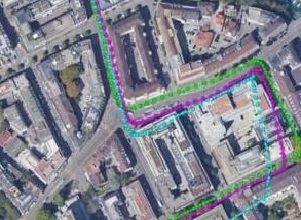Telematics in Electric Vehicles
Nishchal Chaudhary, BattRE Electric Mobility
Telematics, in the most straightforward sense, is the integrated use of telecommunications and information technology to send, receive, and store data. It is a key component of the Internet of Things (IoT), as it allows devices to communicate with each other in real-time. Consequently, telematics, as a communication technology and a decision support science, has today grown in popularity both among the manufacturers as well as the users of this discipline. In a nutshell, vehicle telematics combines automotive technology with computer science, communications tech, data sciences, and locational systems such as GPS to create new opportunities for digitalized automobiles, both 2- and 4-wheeler and everything else too, in order to generate increased and better outcomes operational efficiency, improved flexibility, and, in general, all-around better results.
The origin of telematics can be traced back to the early 1960s when the first satellite communications systems were developed. These early systems were designed to transmit voice and data over long distances, enabling communication between remote locations and the rest of the world. However, the cost and complexity of these systems meant that they were primarily used by the military and government agencies.
It was not until the 1990s that telematics began to emerge as a commercial technology, driven by advances in microelectronics and wireless communications. The first telematics systems were developed for the automotive industry, with the goal of improving vehicle safety and performance. The first commercial application of telematics was in the trucking industry, where it was used to improve fleet management and optimize delivery routes. Telematics systems were also used in the insurance industry. In the early 2000s, telematics began to expand beyond the automotive and insurance industries, with applications in areas such as healthcare, logistics, and energy management. Today, telematics has become a ubiquitous technology, with applications in virtually every industry and sector.
The development of advanced sensors, artificial intelligence, and cloud-based computing has further expanded the capabilities of telematics, enabling real-time data analysis and insights that were once impossible. Looking to the future, telematics is poised to play an even greater role in shaping the way we live, work, and interact with the world around us.
What has happened recently, especially with environmental consciousness taking a more prominent position amongst manufacturers and buyers as well as with policymakers, Electric Vehicles are growing in number and intensity. This has led to a new wave of telematics solutions designed specifically to address the challenges of transitioning to and operating an EV fleet—electric vehicle telematics. Electric vehicle telematics is simply the application of automotive telematics systems to electrified fleets. EV telematics allows fleet managers to run more efficient fleets and adapt to the inevitable changes that are coming with electric vehicles.
The technical building blocks
Electric Vehicle Telematics technology typically involves several different components. The first is a telematics device, which is installed in the vehicle and is responsible for collecting data. This device can be either a standalone unit or integrated into the vehicle’s onboard computer system. The data collected by the device is transmitted wirelessly to a central server, which can be accessed by authorized users through a web portal or other interface.
Telematics devices typically include several types of sensors to collect different types of data. These sensors can include GPS sensors, which are used to track the vehicle’s location and speed, as well as accelerometers, which can be used to detect sudden changes in speed or direction. Other sensors may include fuel level sensors, engine diagnostics sensors, and driver behaviour sensors, which can be used to monitor factors such as harsh braking, acceleration, and cornering.
In practical terms, a vehicle which is integrated with telematics usually has a robust, crash-resistant, ‘black box’ with a complex electronic control unit (ECU) inside it. This black box also referred to as the T-Box, is the core telematics control unit (TCU). The TCU has various components, but broadly it comprises the following:
ECU Network – Inside the vehicle, there is an interconnected network of automotive ECUs which help the Telematics Control Unit to collect vehicle data such as engine temperature, vehicle speed, diagnostics information, etc.
Telematics Control Unit (TCU) – This control unit is the heart of the telematics device. It has communication interfaces with the vehicle’s CAN (Controller Area Network) bus and the IoT cloud server, streamlines Human Machine Interface data streams, and manages the memory and battery of the device as well. The bi-directional communication with the cloud server is established through a cellular, LTE, or GPRS network.
IoT Cloud Server – The information that is collected by the telematics control unit is shared with the cloud-based telematics server through a highly secure GPRS or cellular network. On the IoT cloud platform, the data is extracted and stored in databases for processing.
The industry landscape
The industry applications of telematics are today considerably mainstreamed, and it is no longer just an academic or frontier engineering discipline as it was perhaps a couple of decades ago. Consequently, telematics has acquired an industry complexion on its own merit and potential. The global market size of the telematics industry was valued at $35.4 billion in 2020, and it is projected to grow to $62.2 billion by 2025, with a CAGR of 12.0% during the forecast period. This growth is driven by the increasing demand for advanced safety and security features in vehicles, the rise in the use of connected car services, and the need for better fleet management.
This industry is also characterized by the growing use of advanced technologies such as artificial intelligence (AI), machine learning (ML), and the Internet of Things (IoT). These technologies are being used to develop more sophisticated telematics solutions that can provide real-time data on electric vehicle performance, driver behaviour, and environmental conditions. The industry is dominated by a few key players but there are also many smaller companies that specialize in specific areas of the telematics industry, such as fleet management or vehicle tracking.
Geographically, the telematics industry is dominated by North America and Europe, which together account for more than 60% of the global market share. This is due to the high penetration of connected car services in these regions, as well as the presence of major telematics companies.
Globally, according to a recent report, the automotive telematics market is poised for rapid growth over the next few years, with 88 per cent of new vehicles (roughly 104 million) expected to have some form of connectivity by 2025. In India, the commercial telematics market size was around 1,212 million USD and is expected to touch 3,640 million by 2028, growing at a CAGR of 19 per cent between these years.
EV telematics’ solutions
In a broad sweep, electric vehicle telematics providers typically offer a combination of IoT vehicle telematics solutions, cloud, hardware, and software solutions, including GPS tracking, cloud-based platforms with easy integration for multiple partners, telematics sensors, fleet management software, streamlined and accessible dashboard with visualizations, reporting capabilities, automated and configurable notifications and alarms, compliance parameters, and real-time AI integration for early warnings and instant insights.
Telematics integration with CASE (CONNECTED, AUTONOMOUS, SHARED, ELECTRIC) vehicles is becoming increasingly popular. While it has been commonplace for higher-end electric vehicles such as the latest four-wheelers, including commercial vehicles and PVs to have telematics as a standard inclusion along with many rider assistance features, this has now started gradually getting picked up in the two-wheeler segment as well. The two-wheeler industry is ringing in an era of intelligent motorbikes and e-scooters, integrated with telematics and smart-assistance capabilities. The integration of these digital features is expected to take the motorcycling experience to a whole new level!
Applications galore
In the context of 2-wheeled electric vehicles, telematics has numerous cutting-edge applications that are transforming the riding experience and enhancing safety and efficiency. These can be roughly encapsulated as under:
Real-time tracking and monitoring: Telematics can enable real-time tracking and monitoring of electric 2-wheeled vehicles. This can be useful for fleet management, vehicle security, and location-based services. Real-time tracking can also help riders navigate unfamiliar roads and plan their routes more efficiently.
Predictive maintenance: Telematics can also be used to monitor the health of the EV and predict when maintenance is needed. This can help riders avoid breakdowns and prevent costly repairs.
Rider behaviour analysis: Telematics can also be used to analyse rider behaviour and provide feedback to riders on how they can improve their riding skills. This can help riders reduce their risk of accidents and improve fuel efficiency.
Safety features: Telematics can also be used to enhance safety features on 2-wheeled electric vehicles. For example, sensors can detect when a rider is in danger and automatically trigger safety features such as anti-lock brakes, traction control, and airbags.
Connected services: Telematics can enable a range of connected services for 2-wheeler riders. For example, riders can use telematics systems to access information on traffic conditions, weather, and nearby amenities such as gas stations and restaurants.
Insurance: Telematics can also be used to enhance insurance services for EV 2-wheeler riders. Insurance companies can use telematics data to offer personalized insurance products based on riders’ driving behaviour.
The proliferation of electric vehicles has led to a new wave of telematics solutions designed specifically to address the challenges of transitioning to and operating an EV fleet—electric vehicle telematics.
Caveats and limitations
While electric vehicle telematics has the potential to transform transportation, there are also several limitations and challenges that need to be addressed. Here are some of the most significant challenges:
Data Privacy and Security: Telematics generates a large amount of data, and ensuring the privacy and security of this data is a significant challenge. Unauthorized access to this data can lead to theft or misuse of personal information, and the potential for cyber-attacks is also a concern.
Cost: Telematics hardware, software, and services can be expensive, especially for small and medium-sized businesses. The cost of implementation and maintenance can be a barrier to entry for some companies.
Technical Complexity: Telematics technology is complex and it can be challenging for some companies to implement and maintain.
Interoperability: There are many different telematics systems and providers, and ensuring interoperability between these systems can be a challenge. This can lead to inefficiencies and increased costs.
Connectivity: Telematics requires a reliable and robust connectivity infrastructure. In some areas, especially in developing countries, the availability and quality of connectivity may be limited.
Regulatory Compliance: Telematics data is subject to regulations such as data privacy and security laws. Companies need to ensure that they are compliant with these regulations, which can be a challenge in some regions.
Overall, these limitations and challenges need to be addressed to ensure that telematics technology can reach its full potential. By addressing these challenges, telematics has the potential to provide significant benefits to transportation companies, governments, and society as a whole.
Optimizing integration
It is true that telematics integration in electric vehicles can be expensive, particularly for small and medium-sized businesses. However, there are several measures that can be taken to reduce the cost of telematics integration:
Consider the Total Cost of Ownership: When evaluating different telematics solutions, it’s important to consider the total cost of ownership, not just the upfront costs.
Select a Scalable Solution: When choosing a telematics solution, consider one that can be scaled up or down depending on your needs.
Leverage Existing Technology: If vehicles already have other technologies present, look for telematics solutions that can integrate with these.
Focus on Key Features: Identify the most critical features for your business, such as GPS tracking or driver behaviour monitoring, and focus on solutions that offer those features.
Use Open-Source Solutions: Consider open-source telematics solutions, if possible.
Consider Subscription-Based Services: Some telematics vendors offer subscription-based services that can be more affordable compared to purchasing hardware and software outright.
Horizons ahead
The most critical advances in vehicle telematics include connected cars, 2-wheelers, vehicle-to-vehicle (V2V) and vehicle-to-everything (V2X) communication, and intelligent transport systems. Connected EV technology offers drivers and riders additional safety, convenience, and entertainment features through the use of cellular data and GPS. V2V communication allows vehicles to connect with one another and exchange data, such as speed and direction, for improved safety and automated driving.
Looking to the future, telematics integration with CASE vehicles is expected to become even more advanced. Autonomous features, such as lane-keeping and adaptive cruise control, are being developed to make driving safer and more efficient. Additionally, telematics systems will be used in conjunction with other smart technologies, such as on-vehicle entertainment, to provide an even more complete and assured experience to drivers and riders.
The telematics industry is a fast-growing sector that is driven by the increasing demand for connected car and 2-wheeler services, advanced safety and security features, and better fleet management solutions. With the use of advanced technologies such as AI and IoT, the industry is expected to continue to grow at a rapid pace in the coming years.
Author:

Nischal Chaudhary, Founder, BattRe Electric Mobility
Nishchal Chaudhary is an Indian entrepreneur and the founder of BattRE Electric Mobility, which is a start-up focused on manufacturing and selling electric scooters in India. He started BattRE Electric Mobility in 2017, with the aim of providing eco-friendly and sustainable mobility solutions to the Indian market.


